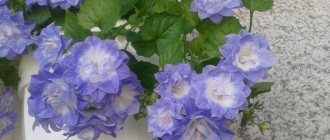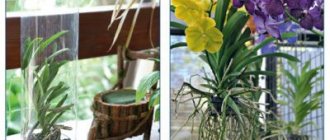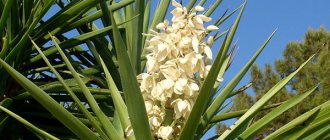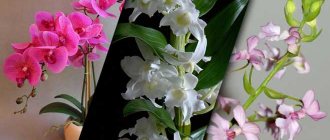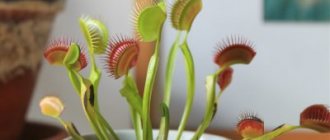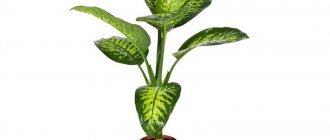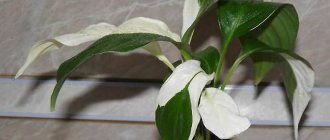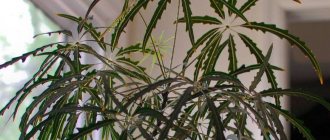Peperomia magnoliafolia is an evergreen, perennial plant of the Pepper family. Native to America and tropical Asia. Prefers loose peat substrate, forest canopies, rock gorges, and tree trunks with rot. Translated from Greek it means “like pepper.” Depending on the variety, it can reach from 15 to 50 cm in height.
Grows as epiphytes and subshrubs. Forms thickened shoots and fleshy leaves. Bisexual, tiny flowers form cylindrical spikelets. But flowering occurs only with short daylight hours. After flowering, red fruits appear. Easily fall off when touched. Let's take a closer look at how to properly care for a decorative flower at home.
Features of home care
The plant is especially popular among gardeners.
In nature, the flower lives in humid and hot forests. Unlike its neighbors, it does not require additional moistening of the substrate. Does not require a pronounced resting stage. Therefore, all care conditions can be observed all year round.
Watering
Leaves and stems can accumulate large amounts of moisture. Drought is not a problem for her. More problems arise from excessive waterlogging. Violation of care recommendations causes rotting of the stems and roots. For watering, use filtered or settled water. Its temperature should be 2 degrees higher than in the room.
In summer, water as the substrate dries. In winter, moisten the soil once a week. You can easily tell when a plant is lacking moisture. The lower leaves will fall off.
Choosing a suitable place
Windows in the western or eastern part of the building are suitable for growing. The plant on the southern windowsill needs darkening. Close the window during periods of intense light (from 11.00 to 14.00) with roller shutters, blinds or regular fabric. Experienced flower growers do not recommend placing flowers on the veranda or balcony in the summer.
Lighting
Provide the plant with bright light. Varieties with bright and variegated leaves especially need such care. Protect vegetative organs from direct sunlight. Dangerous burns may occur.
Pay attention to the color of the leaves. Dark varieties can withstand more darkness. To maintain decorativeness in winter, daylight hours should be extended. Use fluorescent lamps for additional lighting.
The plant can only exist due to artificial lighting. But in this case, you need to use the devices for about 16 hours every day. Please note that plants from garden centers will need time to adjust.
Temperature
Peperomia magnoliafolia will need +22 - +24 °C for full development in spring and summer. In the cold season, the temperature is allowed to drop to +19 °C. At +15 °C the plant may die.
Please note that for growth you also need to control the temperature of the substrate. It should not fall below +17 °C. Avoid sudden changes in temperature, drafts and strong gusts of wind.
Humidity
The plant can develop well at 30% air humidity. But still, the optimal level is on average 60%. You can increase the rate by spraying water. But keep in mind that this procedure can only be carried out on crops without fuzzy leaves.
Experienced gardeners advise placing a container filled with warm water, wet coconut fiber, expanded clay, pebbles or moss next to the flowerpot. A similar effect is exerted by proximity to other representatives of the flora. You can move the flowerpot to the kitchen. The constant evaporation from cooking helps the flower grow. Never add water to the stand. The root system will begin to rot.
You can learn how to care for a plant at home from the video:
Transplant technology
It is better not to disturb the plant again. Crops need to change the substrate and container annually for up to 3 years. Adult plants can be transplanted using the transshipment method in early March. Carry out the procedure once every 3 years. Varieties with small leaves need to be replanted more often.
You can also determine the plant's need for replanting based on several signs. Peperomia magnoliafolia will stop development. There are no signs of damage or disease. The roots have grown through the drainage holes. The soil mixture in the container may also become excessively compacted. This negatively affects the condition of the flower.
The transplant is very easy:
- Fill the third part of the container with expanded clay, pebbles or crushed foam. To disinfect, add a little wood ash.
- Add the prepared soil mixture on top, but no more than 2 cm. Pour water and let it soak.
- Then remove the flower from the pot. To avoid damaging the roots, leave the earthen ball intact.
- Place the peperomia in a new container.
- Fill the remaining space with soil and carefully level it. The ground level should be 1.5 cm below the edge of the container.
- Moisten the soil and place the flower in a warm room with diffused sunlight.
- After 2 weeks, you can transfer the plant to a permanent growing location.
Trimming
To form a flower, you can periodically prune. Use the removed parts for propagation. Try cutting one stem. There should be at least 15 cm left.
Plant the resulting cuttings in a separate container. Over time, side shoots will begin to form from the remaining part. At this stage, you can cut off another shoot. Try to root the apical part. Then plant both crowns in one container. This way you will get another pot with new plants.
To successfully grow a flower, you will not need additional moisture in the environment.
Botanical description of the plant
This herbaceous evergreen perennial belongs to the Pepper family and is one of the most popular varieties of peperomia. A small bush grows up to 25–30 cm.
Did you know? Translated from Greek, the expressions "peperi" and "omos" mean "pepper" and "similar".
The characteristic signs of peperomia magnolia leaf are as follows:
- fleshy branched stems with large nodes;
- rounded leaves about 5 cm in diameter with short petioles;
- the surface of the sheet is glossy;
- the leaves are colored in different shades of green; there are varieties with spots or pale yellow stripes.
Peperomia is grown to produce beautiful foliage, since its flowers are not particularly decorative - they are small dense spikelets of light green color. Flowering occurs in spring or summer.
Outdoor breeding
The plant cannot easily withstand hypothermia. For example, during transplantation the temperature should not be allowed below +17°C. Also, the flower may suffer on a cold windowsill. You will have to change the planting location or place a sheet of foam under the flowerpot.
Due to this increased sensitivity, peperomia magnoliafolia cannot be grown in an open area. There are several varieties that can be kept outdoors in a container in the summer. But in this case, it is necessary to create favorable conditions.
List of the most striking species and varieties of Peperomia
As mentioned above, there are about 1,500 species in the genus Peperomia, and the number of varieties cannot be counted. We have analyzed the most popular species and varieties among domestic flower growers and would like to present a short list of the most popular ones.
Peperomia caperata
This species is notable for its short stems and heart-shaped leaves with deep ridges. The leaves are green, sometimes with a red blush and dark green veins. In summer and early autumn you can see thin flower stalks.
They rise high above the foliage, growing from the base of the plant with reddish-purple stems. On the Internet you can find many varieties of Peperomia corrugata, which often bear little resemblance to the mother species. The most common of them:
- Peperomia Rosso. Probably the most famous variety. This compact plant grows up to 20 cm in height and width. Fleshy, dark green, corrugated, heart-shaped, wrinkled leaves grow at the ends of long stems. The leaf has a length of 2 to 4 cm.
The stems, as well as the lower part of the leaves, have a reddish tint. The flowers are odorless, greenish-white, very small in spring and summer, opening at the ends of reddish spikes 5-8 cm long. - Peperomia caperata 'Frost' is a beautiful compact houseplant with beautiful wavy heart-shaped foliage that is a silvery matte green. This shrub plant reaches a height of 12-20 cm and the same width. The greenish-brown flowers are small with pointed stems and bloom from June to August.
- Also worth mentioning are such varieties as Peperomia 'Red Ripple' and Peperomia 'Lilian' .
Watermelon or silver peperomia (Peperomia argyreia)
This species has gained popularity among indoor plant lovers due to its stunning watermelon-like foliage. This is a compact flower native to South America.
At maturity it reaches 30 cm in height and 20 cm in width. The leaves are asymmetrical, oval, slightly fleshy with pronounced curved silver stripes, and red stems. Tiny green flower stalks appear in summer.
Peperomia magnoliaefolia
It is a small houseplant with upright stems and large leaves. The flower spreads through adventitious stems, forming mats or tussocks of shiny green leaves. The flowers are small, pale green and densely packed into thin spikes that sometimes branch at the tips.
Flowering occurs throughout the year in adulthood. This species has two varieties: one is tricolored and the other is variegated.
Peperomia prostrata
It is a beautiful hanging flower with fleshy, round, dark green to purple leaves with a beautiful pattern of whitish veins.
The height of the plant does not exceed 10 cm. Creeping long hanging branches of round patterned leaves add charm to the flower, due to which it is usually kept in hanging flowerpots.
Peperomia obtusifolia
In the West, this species is better known as the American rubber plant. It is a bushy flower growing up to 30 cm in height with thick, erect stems. The leaves are elliptical, dark green with a waxy coating, up to 15 cm in length.
The flowers are small, greenish-white, collected in long narrow spikes, bloom from spring to autumn. Also popular is the variegated form of Peperomia obtufolia, which is shown in the photo.
Peperomia polybotrya
In its homeland, this species is also called teardrop-shaped Peperomia. The plant does not grow higher than 30 cm. Although some varieties can grow up to 60 cm. The stems of the plant are quite strong.
The leaves are fleshy and quite juicy - primarily due to the water they store - heart-shaped, shiny dark green with a glossy sheen and a pale green tint on the underside. The flowers are collected in long spikes, often resembling spikelets. They emit a rather sweet smell. The most famous variety is Peperomia Raindrop or Peperomia Raindrop .
Finally, we would like to invite our readers to watch a video of a collection of domestic Peperomias.
The article uses materials from the site peperomia.net
Container growing technology
soil mixture
For breeding at home, experts recommend using a substrate that perfectly allows moisture and air to pass through. Let's consider the best options for soil mixture:
- Universal soil for succulents. You can prepare the mixture yourself from peat, leaf humus and coarse river sand.
- Soil for ficus or palm trees is also suitable. You must add vermiculite or perlite to it.
- Humus, garden soil, moss, coconut fiber (crushed), fine expanded clay (no more than 3 mm).
You can avoid all soil problems if you use hydroponics for cultivation. You can also create an elegant composition with the help of a plant. Moss or driftwood is suitable for this.
Top dressing
Experienced gardeners recommend using complex fertilizers in liquid form for peperomia magnolia leaf. They can be purchased at any store. For processing, you need to reduce the dosage specified in the instructions by half.
Container options
Wide, low dishes are suitable for growing flowers. With each transplant, increase the diameter of the container by one and a half times. Don't use a large flowerpot. Unfortunately, peperomia develops very slowly. Therefore, all the energy will be spent on growing the root system.
How to transplant
If the peperomia loses its appearance and stops growing, check to see if the pot has become too cramped. Perhaps it's time to think about a transplant.
Despite the powerful shoots, the roots of peperomia are short and weak. Therefore, flower growers advise using a shallow container with a solid drainage layer (4-6 cm) for planting.
Transplantation is carried out no more often than once every 2 years. It is best to do this in the spring. The old flower is replanted only when the roots begin to appear from the drainage hole.
As a primer, you can purchase a ready-made substrate for exotic plants. If you want to make the mixture yourself, include the following ingredients: turf and garden soil, humus, peat and coarse sand. Ratio 2:2:2:1:1. Instead of sand, perlite is suitable. It is very important that the soil is loose. Roots easily rot in compacted soil.
The container is chosen 3 cm larger than the previous one. There must be holes for drainage. The pot should not be too spacious. The flower does not feel well in large containers.
Characteristic problems and diseases
In a room with dry air, spider mites may appear on peperomia. Determining a pest settlement is quite simple. A web appears on the stem (usually in the internode). The leaves wither and fall off.
You can get rid of tiny insects using a soap solution. Then you need to shower with warm water. Spray the plant with water periodically. Severely affected peperomia should be treated with Actellik. For 1 liter of water you will need 2 ml of product. A 0.15% solution is suitable.
Thrips prefer rooms with high temperatures and low humidity. The operation of heating appliances especially contributes to such conditions. The pest primarily attacks the lower part of the leaf. You will notice light spots on the top plate. Eventually the leaf on top will turn brownish-gray with a silvery tint. It is quite difficult to detect the parasite after settling on variegated varieties. You can get rid of the insect by spraying with insecticides.
The plant may also suffer from mealybugs. The pest will die after treating the leaves with alcohol. Use a regular cotton pad for cleansing.
Fungal infections can cause root and root collar rot. They occur as a result of waterlogging or soil compaction. At the initial stage, you can save the flower. To do this, reduce the number of waterings; if this does not help, replant the plant.
There are known cases of peperomia infection with a virus that causes dwarfism. It is necessary to immediately destroy the plant along with the soil and container. Otherwise, other crops may suffer.
Diseases and pests - how to fight
Peperomia can be affected by some diseases and pests. To eliminate the problem in time, periodically monitor the condition of the plant. Parasites and symptoms of infection may be as follows.
Spider mite
Its presence is indicated by the appearance of a white fibrous coating. First of all, the plant is carefully washed with warm water. After this, they are treated with an insecticide.
Trips
Pests drink the juice from the leaves, after which they become covered with dry spots. They lay larvae on the reverse side. If a problem is detected, the leaves are washed with soapy water. For processing, you need to purchase a special preparation in the flower department.
Flowering and beneficial properties
It is recommended to keep Peperomia magnolia folia in the bedroom or living room. The plant promotes a friendly atmosphere in the home. According to experts, the culture supports the energy field of the room with its variegated color, bushy shape and numerous leaves. Negative emotions are smoothed out.
The plant is able to delight and warm its owners. In addition, cultivation improves health. Positively affects the condition of the mammary glands, gall bladder, and gastrointestinal tract.
A small plant can be placed on your desktop.
Releases phytoncides. The component purifies the air from harmful microorganisms. Therefore, it is recommended to keep the plant in the children's room. Especially if the child is often sick.
Appearance of the plant and its photo
In botany, the term “variegation” means variegation. That is, in each variety you can select this type of foliage. There is dull-leaved, magnolia-leaved, clusiel-leaved variegated peperomia .
- The leaves of the blunt-leaved variegated subspecies are usually creamy white with a green center. As a rule, they have a border and a grayish pattern. The trunk itself is creeping and large. The leaves are round and dense.
- Magnolia variegata looks different. This is a plant with erect leaves and vigorously branching shoots. The foliage is fleshy, wide, with white or yellowish spots.
- Clusifolium is a large plant with thick reddish stems. The leaf blade is light, milky in color with a slight red coating, small lightish specks and burgundy edging.
This flower does not occur in nature , so its distribution around the world depends only on the person.
Below you can see a photo of the plant:
Reproduction technique
It is very easy to spread peperomia at home. Even a novice florist can handle it. You can find planting material in almost any gardening office or specialized online store. Let us examine in more detail the methods of flower propagation.
Peperomia magnoliafolia from seeds
It is not necessary to buy rudiments in the store. Seed material can also ripen at home. Collect the seeds in bags (preferably using paper). Store in a dry place, away from direct sunlight until the end of April. Then start planting:
- Prepare a flat, shallow dish. Fill it with substrate. A mixture of universal purchased soil for indoor ornamental plants and coarse river sand is suitable.
- Moisten the soil.
- Scatter the seeds on the surface of the substrate.
- Cover the top with a thin layer of soil (no more than 2 mm).
- Spray warm water from a spray bottle. Cover the top with a plastic bag or glass for a greenhouse effect.
- Provide optimal conditions. The rudiments will need bright lighting and an air temperature ranging from +24 to +27 °C. You can also organize bottom heating. A regular heating pad will do. Open the greenhouse every day for fresh air. This will prevent condensation and rotting.
- Do not allow the substrate to dry out. Spray it regularly, as needed.
- When the sprouts have 2 full leaves, transplant them into separate containers. As a substrate, use a mixture of universal soil, peat, fertile soil and clean sand.
- With proper care, about 6 leaves will form in six months. At this stage, you can dive them into pots. The average diameter of the container should be 8 cm. Further care is no different from adult plants.
Cuttings
For propagation, use the upper part of the shoot. The middle part of the stem will also work. Just clean it of leaves first. Please note that the success of the procedure depends on the number of nodules. Each cutting must have at least two growth points. As a rule, about 80% of planted shoots take root.
Experienced gardeners also propagate peperomia by leaf. But for this you will need an adult plant over 3 years old. The crop should not show damage or other signs of disease. Shorten the petiole to a minimum.
The procedure includes several stages:
- At the end of October, cut the cuttings. Use a sharp, sanitized knife.
- Place the shoot in a container with a root stimulator. You can also disinfect planting material with a weak solution of potassium permanganate. 3 hours of processing is enough.
- Apply activated carbon or crushed chalk to the affected area. Leave to dry for an average of 24 hours.
- Several substances are suitable for rooting - sand, water, peat, vermiculite or moss. Please note that the cuttings from the apical part must be inserted into the substrate with the cut side down. It is better to place stem planting material horizontally.
- Cover the top with a plastic bottle (cut) or glass jar. Maintain the ambient temperature between +25 and +27 °C.
- Do not allow the substrate to dry out.
- Under favorable conditions, roots will form in an average of 3 weeks. Let them get stronger and transplant the cuttings into a standard peperomia substrate.
With the help of cuttings, you are guaranteed to preserve the varietal characteristics of the plant.
Dividing the bush
It is advisable to carry out the procedure during spring transplantation. Divide a large peperomia bush into several parts. The procedure is no different from those described above. Use a clean, sharp knife to separate. You can prevent rotting using activated carbon. Treat the cut area with it.
Variety of species
Peperomia belongs to the order of evergreen perennial plants of the Pepper family and has about 1,100 species. Some of them bloom periodically, and about 30 subspecies are grown as houseplants. Almost all of them come from the tropical forests of South America.
Peperomia with variegated leaf color
The most common types of indoor peperomia:
- Fragrant - with pinkish-green leaves.
- Nivali - resembles mini palm thickets.
- Mountain - with cup-shaped, almost round leaves and inconspicuous peduncles.
The variety of types of peperomia
Connoisseurs of everything unusual give preference to the following varieties:
- Wolfgan Krahn - distinguished by a carved frame of greenery.
- Dolabriformis - the leaves of the flower are arranged in such a way that they resemble a large flower.
- Hutchison's Peperomia is a bluish-blue, almost gray plant, somewhat similar to a sea creature.
Peperomia Magnolifolia is one of the representatives of the large Pepper family. The flower differs from its other brethren in its large, massive leaves, similar to magnolia leaves, which is why it received its name. Their color is extraordinary; there are varieties with light green, dark green, even brownish shades, with various inclusions, stripes and borders. The characteristic waxy coating gives the greenery its brightness. The stems are fleshy and quite dense.
The bush can reach a height of 30 cm. The flowers resemble the flowering of an ordinary plantain. The culture is loved by flower growers for its decorative foliage and its ability to release beneficial vapors of phytoncides into the air - excellent helpers in the fight against pathogenic bacteria.
Important! When purchasing a plant in a store, you need to pay attention to the richness of the colors of the foliage. Limp and dull leaves with damage indicate insufficient nutrition and improper growing conditions. After transportation, such a plant is unlikely to survive
After transportation, such a plant is unlikely to survive.
Choosing planting material
Peperomia magnolia folia in a container 35 cm high and 14 cm in diameter can be purchased for 1,658 rubles. In garden centers you can often find peperomia "Lillian" and peperomia cluzifolia. Be sure to pay attention to the absence of pests. Examine the flower.
A characteristic white coating resembling powder or brown scales indicates damage to the crop. Never purchase peperomia with drooping leaves. Especially if the container contains a wet substrate. This may be a sign of rotting root system.
For garden cultivation, you can buy one of the forms of the crop - Variegata. It is distinguished by a special structure of vegetative organs and yellow-white spots. For outdoor cultivation, special conditions must be created. Follow the basic rules of care, and the plant will become a real decoration of your home.
Difficulties in growing
The plant can get sick if the basic conditions are not met.
The main problems of peperomia:
- blackening of the leaves occurs during a sharp cold snap;
- wrinkling of the leaf plate may appear from sunburn;
- limp leaves are a symptom of rotting or fungal infection;
- dropping leaves indicates dry air and lack of moisture.
Peperomia can also be attacked by some pests:
- Spider mites manifest themselves as a fibrous whitish coating. After the destruction of adult individuals, the foliage is treated with Actofit, Sunmite or Vermitek.
- The appearance of thrips is indicated by dry spots on the leaves and a silvery tint to the leaf. For wrestling use “Aktara”, “Mospilan”, “Karate” according to the instructions.
- The mealybug is noticeable on the lower part of the leaf, where a kind of “flour” and sticky secretion is formed. After mechanical cleaning, it is necessary to treat the plant with the preparations “Rogor”, “Phosfamide”, “Aktara”, etc.
The variety of varieties and colors allows you to choose magnolia-leaved peperomia to suit your taste, and caring for it is not difficult. A compact and useful indoor plant suitable for every home.
What is peperomia magnoliafolia?
Peperomia is an evergreen herbaceous subshrub that can be found in the tropical forests of Brazil, Ecuador and Venezuela.
In nature, there are about a thousand varieties of this plant. Peperomia magnolia leaf reaches a height of 25 cm. Its stem is fleshy and highly branched. The oval glossy green leaves are very dense and are attached to the trunk using short petioles.
The flowers of this plant are quite small. They are collected in ears and in appearance resemble plantain inflorescences. Peperomia is grown indoors for its beautiful leaves, which differ in color and size among different varieties.
Plant care
Caring for peperomia at home is quite simple, because even with the most basic actions, the flower feels good. It is better not to replant this plant often, it does not like it. This flower can grow in less sunny conditions; the sun's rays will only burn the leaves. Light exposure will be more useful if the light from room lamps is directed at the peperomia; the more, the better.
The temperature regime of the plant is twenty to twenty-five degrees, which must be maintained throughout the year. The flower does not like drafts most of all.
Watering is important for the plant, but it calmly survives short periods without moisture, which cannot be said about waterlogging. An excess of water in the pot of magnolia leaf peperomia leads to the fact that the stem along with the leaf accumulate moisture, which ends in rotting of the bush. The amount of water a plant should receive varies depending on the season and air temperature. In summer they water more often, in winter - less often. The water used for irrigation must be settled and warm, because the flower does not like low temperatures, even when watering.


